May 7, 2016 | coins, counterfeit, news
Europe is experiencing a rise in counterfeiting circulating coins that governments are saying is causing additional damage to economies. Coins that are experiencing a rise in counterfeiting include the British one-pound coin that will be replaced in 2017, the Swiss 5 franc coin, and the 2-euro coin. While the source of the British counterfeits remain a mystery to law enforcement, reports suspect that Swiss and euro coins are being manufactured in Italy.
In the United States a new wave of collector coins and bullion have been seen in the market. The Professional Numismatic Guild is reporting that following a survey of its member dealers the number of counterfeit coins now on the market is on the risk. In addition to the counterfeit coins many are appearing in counterfeit grading service holders. While an experienced collector may be able to detect most counterfeit slabs, there have been novices who have been fooled by these fakes.
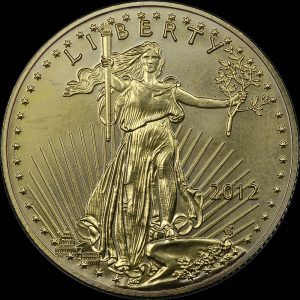
Obverse of a counterfeit 2012-dated American Eagle $50 denomination one-ounce gold bullion coin.
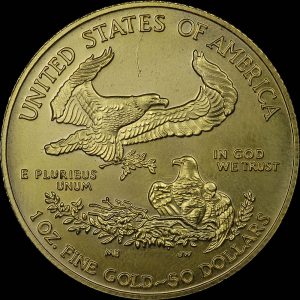
Reverse of a counterfeit 2012-dated American Eagle $50 denomination one-ounce gold bullion coin.
According to PNG, two members who recently were in Asia say they saw counterfeits of Draped Bust, Seated Liberty, Morgan and Peace silver dollars being sold in flea markets in China and Hong Kong for $1 to $3 each. Some are brought back to the United States where they are submitted to third-party grading services where they are returned as counterfeit.
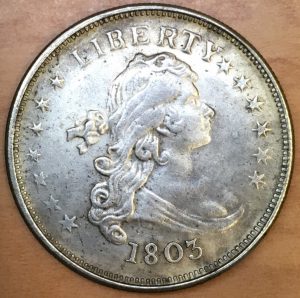
Historic, genuine 1803 Draped Bust design U.S. silver dollars in Very Fine condition are currently valued at about $3,000. This counterfeit 1803-dated dollar was recently offered in a Hong Kong flea market for less than $3.
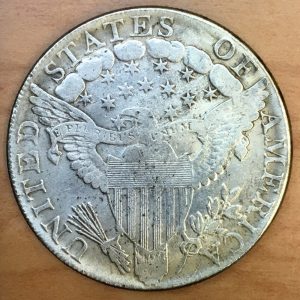
Historic, genuine 1803 Draped Bust design U.S. silver dollars in Very Fine condition are currently valued at about $3,000. This counterfeit 1803-dated dollar was recently offered in a Hong Kong flea market for less than $3.
Many of these counterfeit coins have flaws that someone with experience with these series would easily detect. PNG advises everyone that if you are not sure about the coin, collectors are advised to consult with a PNG dealer who can provide a proper analysis.
While I am not an expert in detecting counterfeit coins, one thing that I notice is that counterfeit modern coins always look too sharp. Their lines are very sharp giving the coins a nearly plastic look. The problem is that gold is a ductile, softer metal which lends to a rounder, more flowing designs when struck. Harder metals can be struck with very sharp edges.
For older coins, aside from design mistakes made by counterfeiters, these coins always have a mushy look to them. While worn coins do not have the struck look to them, they do not wear to where it appears that they were originally struck underwater.
If there are any questions about the authenticity of a coin, always consult a trusted dealer!
Here is the press release issued by PNG:
Use Caution To Avoid Gold And Silver Counterfeits,
Advises Professional Numismatists Guild
(Temecula, California) – Beware of counterfeit vintage rare coins and fake modern gold and silver bullion items now being offered in the marketplace. Purchase only from reputable dealers, cautions the Professional Numismatists Guild (www.PNGdealers.org).
The PNG is a nonprofit organization composed of many of the country’s top numismatic experts.
“It is clear there is an increase in the types of fakes sold by unscrupulous dealers. These sales of counterfeit coins are potentially a multi-million dollar problem for the public. There’s an old saying that can help buyers avoid problems: If you don’t know coins, you better know your dealer,” stated Professional Numismatists Guild (PNG) President Dana Samuelson.
“We conducted an informal inquiry of PNG members and PNG Accredited Precious Metals Dealers (APMD) about what they’re encountering now in the marketplace. They have seen everything from counterfeits of vintage rare coins to modern precious metal items. These include fakes of popular century-old U.S. Morgan and Peace design silver dollars to current gold and silver American Eagles, gold U.S. Buffalo coins, silver and gold Chinese Pandas, and Canadian silver and gold Maple Leaf coins. We’re also seeing spurious gold and silver ingots,” said Samuelson.
“Professional dealers who look at classic U.S. coins and bullion items all day long are usually not fooled by these spurious items, but to the untrained eye they often look like the real thing,” he explained.
“Many of the fakes apparently are originating in China and then offered online by various sellers. It is imperative that collectors, investors and the general public deal only with reputable, knowledgeable experts who offer a guarantee of authenticity,” emphasized Samuelson.
Two PNG members who recently were in Asia say they saw counterfeits of early 19th century Draped Bust, mid 19th century Seated Liberty and late 19th and early 20th century Morgan and Peace silver dollars being sold in flea markets in China and Hong Kong for $1 to $3 each.
Unsuspecting buyers have submitted counterfeit modern bullion coins to Numismatic Guaranty Corporation (www.NGCcoin.com) for authentication and grading. NGC, the official grading service of PNG, earlier reported submissions of counterfeit 2012-dated gold American Eagle $50 denomination coins.
Those particular counterfeits exhibit poorly defined details around Liberty’s face and hair, different fonts for lettering and the date compared to genuine coins and the color is different because the fakes are not composed of gold, according to Max Spiegel, a Vice President of Certified Collectibles Group, NGC’s parent company.
PNG and PNG Accredited Precious Metals Dealers must adhere to a strict Code of Ethics in the buying and selling of numismatic merchandise including bullion coins, precious metal rounds and ingots, and they offer a guarantee of authenticity for the numismatic items they sell.
For a list of PNG-APMD members visit www.PNGdealers.org and click on the APMD navigation link.
May 4, 2016 | coins, commemorative, legislative
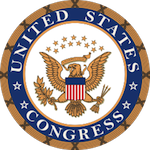 Sen. Bob Casey (D-PA) introduced the United States Semiquincentennial Commission Act of 2016 (S. 2815). This bill is the same as H.R. 4875 introduced in the House by Rep. Patrick Meehan (R-PA) in March. Both bills seek to create a commission to celebrate the nation’s 250th birthday in 2026 similar to the bicentennial celebration of 1976. See last month’s legislative report for more information. It is common for bills like this to be introduced in both chambers hoping one will be passed.
Sen. Bob Casey (D-PA) introduced the United States Semiquincentennial Commission Act of 2016 (S. 2815). This bill is the same as H.R. 4875 introduced in the House by Rep. Patrick Meehan (R-PA) in March. Both bills seek to create a commission to celebrate the nation’s 250th birthday in 2026 similar to the bicentennial celebration of 1976. See last month’s legislative report for more information. It is common for bills like this to be introduced in both chambers hoping one will be passed.
H.R. 4875 can be found at https://www.govtrack.us/congress/bills/114/hr4875.
S. 2815 can be found at https://www.govtrack.us/congress/bills/114/s2815.
S. 2890: A bill to require the Secretary of the Treasury to mint coins in recognition of Christa McAuliffe
Sponsor: Sen. Kelly Ayotte (R-NH)
• Introduced: April 28, 2016
• Referred to the Senate Committee on Banking, Housing, and Urban Affairs
This bill can be tracked at https://www.govtrack.us/congress/bills/114/s2890.
H.R. 2722: Breast Cancer Awareness Commemorative Coin Act
Sponsor: Rep. Carolyn Maloney (D-NY)
• Introduced on June 10, 2015
• Passed the House on June 15, 2015
• Passed the Senate on April 20, 2016
• Signed by the President on April 29, 2016
Read the about the new law at https://www.govtrack.us/congress/bills/114/hr2722.
Summary of the Breast Cancer Awareness Commemorative Coin Act
- Commemorative coins issued in 2018
- Design, emblematic of the fight against breast cancer, selected from a juried competition with no less than $5,000 going to winning design
- “The Secretary shall encourage three-dimensional designs to be submitted as part of the proposals”
- 50,000 $5 “pink gold” coins with an alloy of at least 75-percent gold with a $35 surcharge
- 400,000 one-ounce silver dollars made with not less than 90-percent silver with a $10 surcharge
- 750,000 clad half-dollar coins with a $5 surcharge
- Surcharges will be distributed to the Breast Cancer Research Foundation of New York, to further breast cancer research funded by the Foundation.
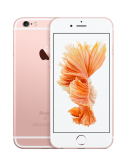
iPhone 6S in Rose Gold
iPhone image courtesy of
Apple.
Apr 30, 2016 | advice, coins, currency, supplies
A reader with questions recently reminded me of a previous version of this article. After reading what I wrote, I noticed a few things that required editing along with some additional information I could add. Rather than keep this to myself, I am sharing so that it can also serve as a reminder to everyone about proper storage.
After putting in the time, effort, and resources to assemble your collection do not just throw it in a draw or closet. Coins, currency, tokens and medals can become damaged if not stored properly. It would be a shame if your collection is damaged when a little effort can keep your collection preserved.
Storing a collection is a matter of dealing with two factors: using archival safe storage materials and the environmental factors of where your collection is stored.
Archival Safety
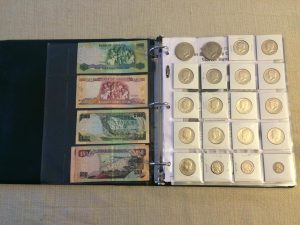 All coins, medals, tokens, and currency are made from materials that will react with the environment. Metals will oxidize and tone, some with patterns that intrigue collectors. Paper-based materials can be made from cotton rag or linen that may not break down the same way as paper but can be damaged in a way that will affect its value. The key to storing your collection is to use products made from archival safe materials. Archival safe materials are those made that are not acidic, materials that do not turn acidic over time, or materials that are not too alkaline.
All coins, medals, tokens, and currency are made from materials that will react with the environment. Metals will oxidize and tone, some with patterns that intrigue collectors. Paper-based materials can be made from cotton rag or linen that may not break down the same way as paper but can be damaged in a way that will affect its value. The key to storing your collection is to use products made from archival safe materials. Archival safe materials are those made that are not acidic, materials that do not turn acidic over time, or materials that are not too alkaline.
Acid free means that the pH (potential Hydrogen) measure is 7.0 or less. A pH measure of 7.0 is neutral and greater than 7.0 is basic or alkaline. Although acidic materials will damage your collection, materials too alkaline will also cause damage. Those that produce acid free supplies with materials that is as close to being pH neutral as possible.
It is possible for some materials to be acid free without being archival safe. These are substances that can breakdown over time and become acidic. For example, commercially made paper contains lignin, a bonding elements that naturally occurs in the pulp that helps holds the wood fibers together. While lignin is not acidic it gives offs acids as it deteriorates. To prevent lignin from becoming acidic it must be treated. This treatment involves dipping the paper in a solution that neutralizes the natural lignin.
Another storage item to stay away from are plastic products made from polyvinyl chloride (PVC). PVC is a inexpensive plastic that is used as an additive to other plastics to make softer, more flexible products. One example of a numismatic product that can be made using PVC are the two-pouch coin holders called flips where each pouch is 2-inches square. PVC in itself is neutral but gives off an acidic gas in reaction to atmospheric conditions. The PVC gas will not only react with the coins but will deteriorate the plastic. The result will be a green or gray streaks or blob appearing on the coins.
The gas produced by deteriorating PVC will damage the surface of the coin. Once a coin is damage by PVC it cannot be reversed. There are ways to conserve coins that are damaged by PVC as long as the PVC contamination is discovered early and is only on the surface. Once it mars the surface, the coin is permanently damaged and its value diminished.

Archival Safe Flips and Cases
Some people like to buy older albums because of they are unique and have a classic look. Those albums may not be made of archival material including paper with active acid from the deteriorating lignin that was not neutralized during manufacture because this was not a concern. Also, cover sliders could be made of PVC or other plastics that are not neutral. If you are not sure whether that used album is safe, it is best to buy a new archival safe album.
Although this discussion centered on coins, the same can be said for currency storage. The only difference will be the size and types of holders.
Environmental Factors
You can use the most archival safe materials but they will not protect your collection from environmental factors. The general rule of thumb is to stay away from the extremes. Do not store your collecting in a place that is too hot or too cold. Try not to store your collection in a place that is too humid or too dry since both could cause your storage materials to react. In other words, the average home with a temperature of 64-78 degrees with an average humidity of 30-percent should not be a problem.
Those living in colder areas where the home heater is being used longer than other areas of the country may have to compensate. Forced air heating systems tend to dry the air that could cause damage to your collection. If you use a humidifier, whether built in to your heating system or a standalone unit, you might consider investing in a hygrometer to keep the relative humidity between 30 and 40-percent.
Where you store your collection also has to be a concern. If you keep your coins in a cabinet, the gasses from the wood and even the paint or stain can cause damage. While wooden cabinets are attractive and practical, you do not want to store your collection some place that could add to the environmental concerns.
Metal cabinets are a better option. Safes and safety deposit boxes in temperature controlled vaults also makes great storage options aside from being able to keep your collection secure.
One of the factors that could cause wood rot in cabinets is excess humidity. If the humidity in your home or where you store your collection cannot be controlled, you should use a desiccant. A desiccant is a substance able to absorb moisture in the air. Two common desiccants are silica gel, the little packets that you see in some packaging, and montmorillonite clay.
Choosing which desiccant to use depends on your situation. If your storage area is not that humid, use silica gel. It well suited for lower moisture area over a longer period of time, about six months. For high humidity areas, use a clay desiccant. Although it will not last as long as silica gel (about three months), clay is more effective at removing moisture where the humidity is higher. Another option is to use a combination, especially during seasons of high humidity. You can purchase silica gel and clay desiccants at many hobby stores and stores that sell collecting supplies.
While there are other types of desiccants, they are not recommended for use around collectibles. Calcium sulfate and calcium chloride uses sulfur and chlorine, both will not react well with the metals of your coins. Activated charcoal can add carbon dust to the air, which can attach itself to your coins. Some have suggested using salt as a desiccant. Salt is made of sodium chloride that would also introduce metal damaging chlorine into the environment.
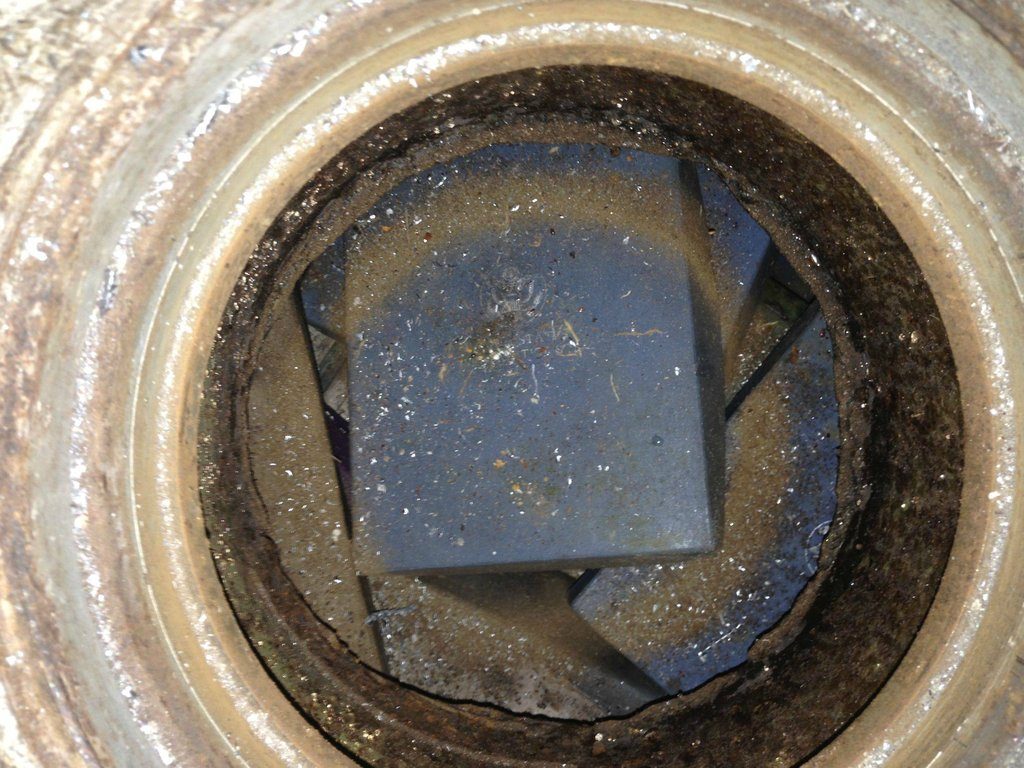
Not all safes are safe for coin storage. Click on the image to read the story about a safe found in the house of the writer’s late grandfather.
Choosing Storage Products
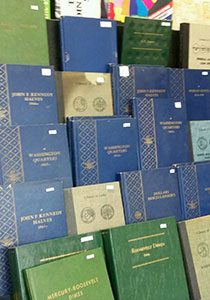
Be careful, old coin albums may not be archival safe!
Albums are popular for raw coins collected in the published series. You can find albums for many series from different manufactures to suit your tastes. Each manufacturer has its own distinct color and style. The difference is your personal preference.
Coins that have been encapsulated by third-party grading services may present different issues for storage and display. While there are a few manufacturers that make a special page to fit the grading service’s holders, collections made up of coins encapsulated by different grading services can be stored in boxes.
When storing grading service holders it is important to remember that the holders are not considered airtight. Third party grading services uses sound waves to melt the halves of the plastic holder to bond them without using chemical adhesives. While this type of sonic seal is strong, it can be subject to breaking if the encapsulated coin is mishandled. Additionally, whatever contaminants were in the air around the time the slab was sealed would be trapped with the coin.
Although most encapsulated coins could be stored in a standard plastic case, those who want extra protection should consider storing the slabs in special archival quality inserts or polyethylene bags.
When storing your collection you can use the same archival quality containers that are used by organizations like the United States Archives or Library of Congress. Although many of the containers may be coated with an alkaline buffer should not be a deterrent. Since your coins are in another holder, whether encapsulated or within an album, the buffer will maintain a barrier between your collection and the storage box that should not hurt your coins.
Although proper storage of your prized collection is important, do not make it more important than your collection. Be careful how you store these items but do so in a way you can still enjoy what you collected.
Image Credits (in order of appearance)
Apr 25, 2016 | ancient, coins, commentary, policy
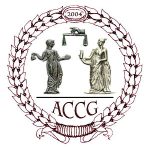 Over the last few years, I have asked readers to sign various petitions and write to the Department of State to stop restrictions on ancient coins.
Over the last few years, I have asked readers to sign various petitions and write to the Department of State to stop restrictions on ancient coins.
Once again, the Ancient Coin Collectors Guild (ACCG) needs your help. This time, the Greek government has requested changes to the Memoranda of Understanding that can hurt ancient coin collectors.
Please read the following letter that was sent by ACCG President Peter Tompa. If you would like to help, please use the links in his letter. Thank you!
Dear Fellow ACCG Member:
The State Department’s Cultural Property Advisory Committee is soliciting public comments for the upcoming renewal of a Memorandum of Understanding with the Hellenic Republic. Current restrictions exempt certain ancient Greek Trade coins, including Athenian Tetradrachms, Corinthian Staters and Tetradrachms of Alexander the Great and his father, Philip, as well as later Roman Imperial and Byzantine coins. On the other hand, many other ancient Greek coins are restricted, including larger denomination coins of many Greek City states and smaller denomination silver and bronze coins of Alexander and his successors.
Please write CPAC expressing concerns about the current restrictions and any effort to expand the current designated list. Comments should focus on how import restrictions have damaged collecting, the preservation of coins, the study of the history they represent, the appreciation of other cultures, and the people to people contacts collecting brings.
While it’s easy to be cynical that public comments are ignored, silence will be taken as acquiescence about the State Department’s actions which have already diminished the supply of ancient coins available on the market.
Comments are due on or before 11:59 PM on May 9th. For a direct link to comment on the government website, go to https://www.regulations.gov/#!documentDetail;D=DOS-2016-0009-0001 and click on the blue “comment now” button in the upper right hand corner of the screen.
For additional background along with suggestions on what to say, see http://culturalpropertyobserver.blogspot.com/2016/03/please-comment-on-proposed-renewal-of.html
For details about what coins are currently restricted, please see https://www.gpo.gov/fdsys/pkg/FR-2011-12-01/html/2011-30905.htm
Sincerely,
Peter K. Tompa
Apr 24, 2016 | coins, gold, US Mint
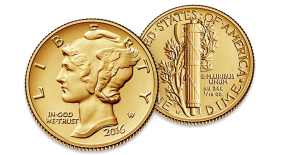 As luck would have it, the day I published my post about my predicted price of the 2016 Mercury Dime Centennial Gold Coin, the U.S. Mint published their prices for all of the centennial celebration coins in the Federal Register. Typical of the way the government does things, the table is too cluttered. As a service to my readers I reproduced the table in a more human-readable form.
As luck would have it, the day I published my post about my predicted price of the 2016 Mercury Dime Centennial Gold Coin, the U.S. Mint published their prices for all of the centennial celebration coins in the Federal Register. Typical of the way the government does things, the table is too cluttered. As a service to my readers I reproduced the table in a more human-readable form.
Price is based on the average price of gold based on the afternoon price of gold as set by the London Bullion Market Association (LBMA). The U.S. Mint uses a Thursday-to-Wednesday week for the average which means that it is highly likely that the Standing Liberty and Walking Liberty gold coins will also be released on a Thursday.
I will add a link to this table under the Collector’s Reference on the menubar for your future reference.
| LBMA Gold Price weekly average |
Mercury Dime Centennial Gold Coin (1/10 ounce) |
Standing Liberty Centennial Gold Coin (¼ ounce) |
Walking Liberty Centennial Gold Coin (½ ounce) |
| $950.00 to $999.99 |
$180.00 |
$397.50 |
$740.00 |
| $1,000.00 to $1,049.99 |
185.00 |
410.00 |
765.00 |
| $1,050.00 to $1,099.99 |
190.00 |
422.50 |
790.00 |
| $1,100.00 to $1,149.99 |
195.00 |
435.00 |
815.00 |
| $1,150.00 to $1,199.99 |
200.00 |
447.50 |
840.00 |
| $1,200.00 to $1,249.99 |
205.00 |
460.00 |
865.00 |
| $1,250.00 to $1,299.99 |
210.00 |
472.50 |
890.00 |
| $1,300.00 to $1,349.99 |
215.00 |
485.00 |
915.00 |
| $1,350.00 to $1,399.99 |
220.00 |
497.50 |
940.00 |
| $1,400.00 to $1,449.99 |
225.00 |
510.00 |
965.00 |
| $1,450.00 to $1,499.99 |
230.00 |
522.50 |
990.00 |
Image courtesy of the U.S. Mint.
Apr 23, 2016 | advice, coins, commentary, legal
If you have not visited Etsy, you will find a shopping site where you can find unique items that are not available elsewhere. Most of the sellers on Etsy sell handmade designs, vintage items, repurposed vintage items, supplies, and unique low volume goods. It would not be farfetched to call Etsy an Internet craft fair and a neat place to go shopping.
One of the more interesting items on Etsy are coin jewelry. Coin designs are themselves a form of art but can become ordinary when repeated over millions of coins. Take a meaningful design and add it to a bezel, attach it to a pendant, or hammer it into a ring and these artists take the coins to the next level.
Many of these artists will take requests for the type of coin for their creations. Some will even let you send a special coin or a coin they cannot obtain to create your design.
A quick search on Etsy for coin jewelry found over 100,000 different jewelry items including bracelets, rings, earrings, bracelets and more. Aside from the different types of jewelry the artists will also use coins from all around the world including the United States, United Kingdom, Canada, Norway, and more.
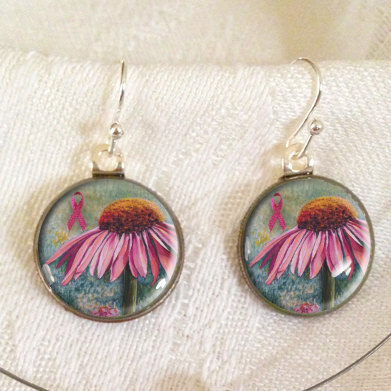
Resin ear rings made by InspiringFlowers using Roosevelt dimes
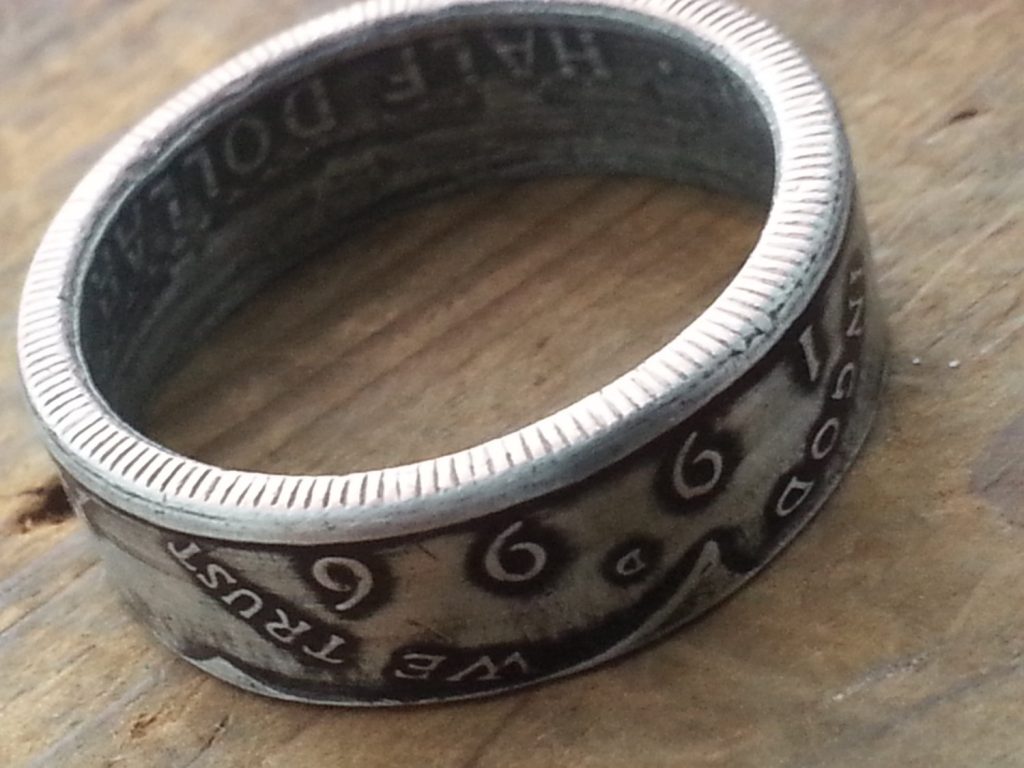
1996 Half Dollar Ring by LuckyLiberty
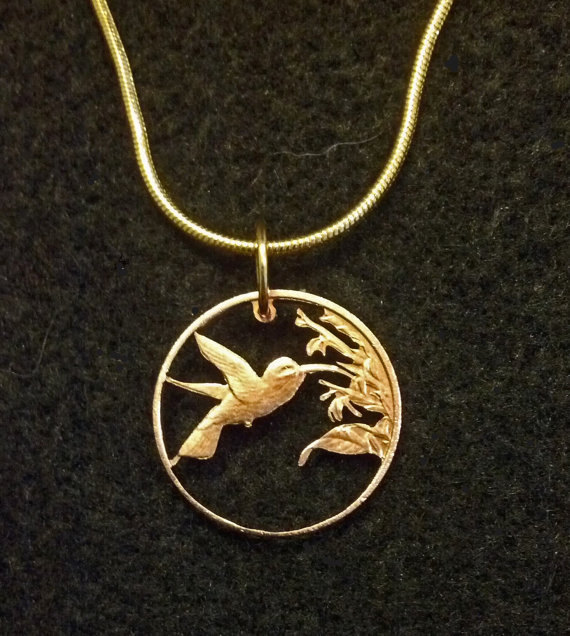
Hummingbird cut from a Trinidad and Tobago penny by SawArtist
Click on the image to visit artist’s store
Coin jewelry hunters may be unknowingly accessories to a crime. According to an article in The Straits Times, it is illegal to make jewelry using coins from Singapore.
Like many other nations, Singapore takes pride in the art on their coinage. Aside from being their means to promote commerce, they are used to represent their culture and society. However, the Monetary Authority of Singapore (MAS), the Singapore equivalent of the U.S. Treasury Department, has said that under Singapore’s Currency Act, it is illegal to “mutilate, destroy or deface” their money. Offenders can be fined up to $2,000.
If you search for “Singapore coin jewellery” (the British spelling of “jewelry”) on Etsy, you will find around 200 different jewelry items returned as part of the search. It is common to see Singapore flower series coin or older coins that featured seahorses.
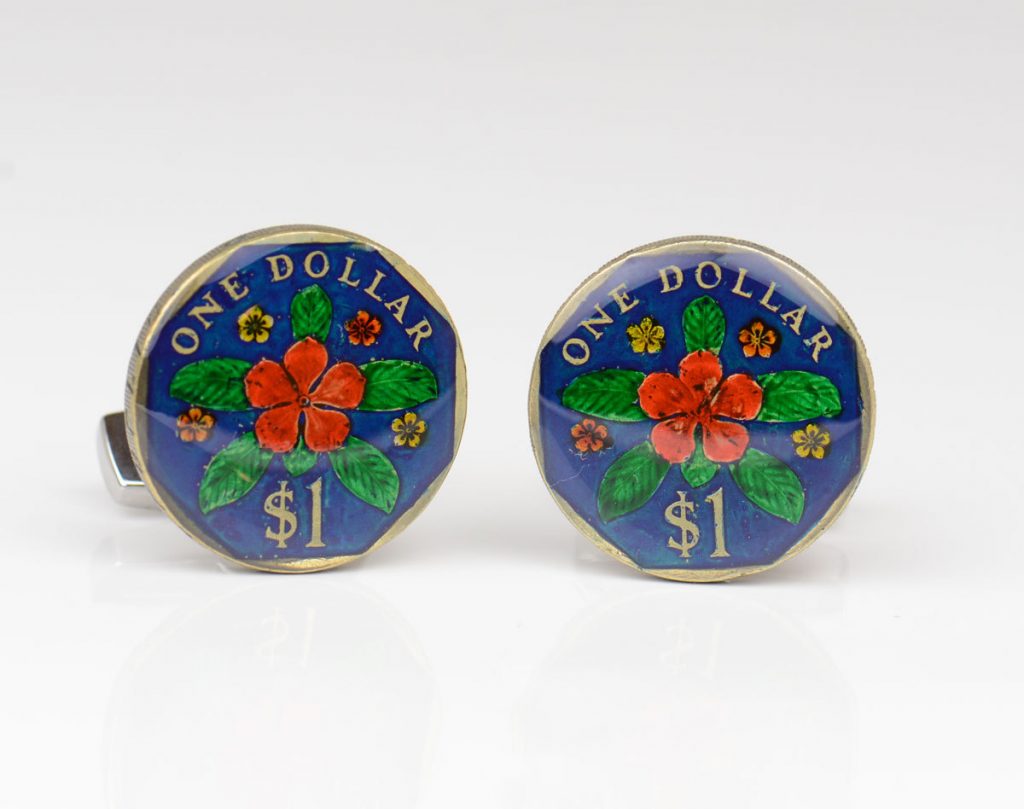
Painted Singapore Dollar coin ring by Monedus
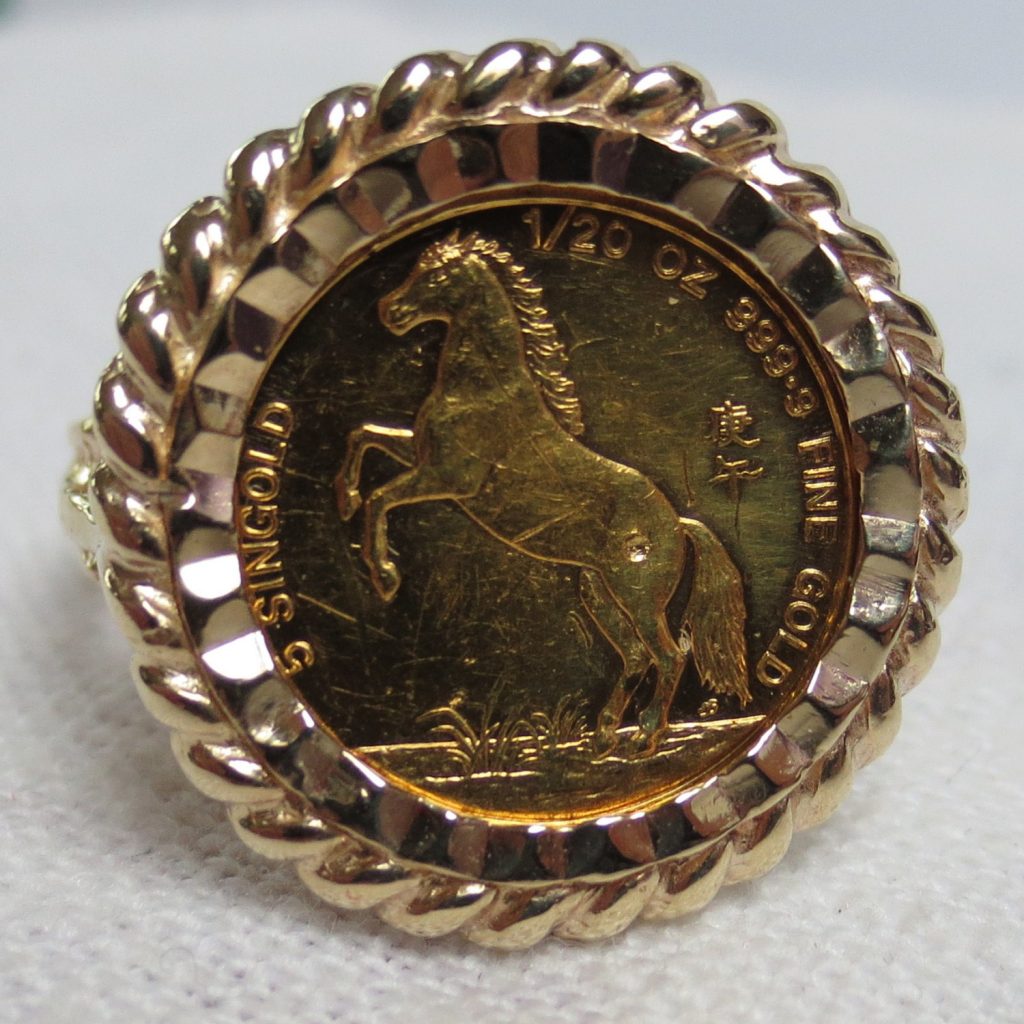
1990 Singapore Horse bullion coin 1/20 oz. in a ring by BritanniaJewelry

Pendant made using a cutout 1979 Singapore coin
Click on the image to visit artist’s store
None of these artists are based on Singapore
While United States law allows for people to use coins for jewelry or other purposes as long as there is no attempt to use them as legal tender currency (18 U.S.C. § 331), this might not be the same for other countries. Although European laws are similar to those in the United States, there is some question as to whether the laws of Canada and Australia can be interpreted to have the same restrictions as Singapore.
When I asked an attorney, he questioned whether an international buyer would convicted of a crime. We both agreed that if you buy jewelry with an international coin, leave it home if you plan to visit that country.
Etsy was asked for a comment but attempts to contact them via email has not been answered.
All images are courtesy of their respective artists on Etsy.
Apr 15, 2016 | bullion, coin design, coins, gold, US Mint
If you read my Baltimore show report, you might have noticed that I included images of the Mercury Dime 2016 Centennial Gold Coin. According to the U.S. Mint, the coin is scheduled to go on sale on April 21, 2016 at noon Eastern Time.
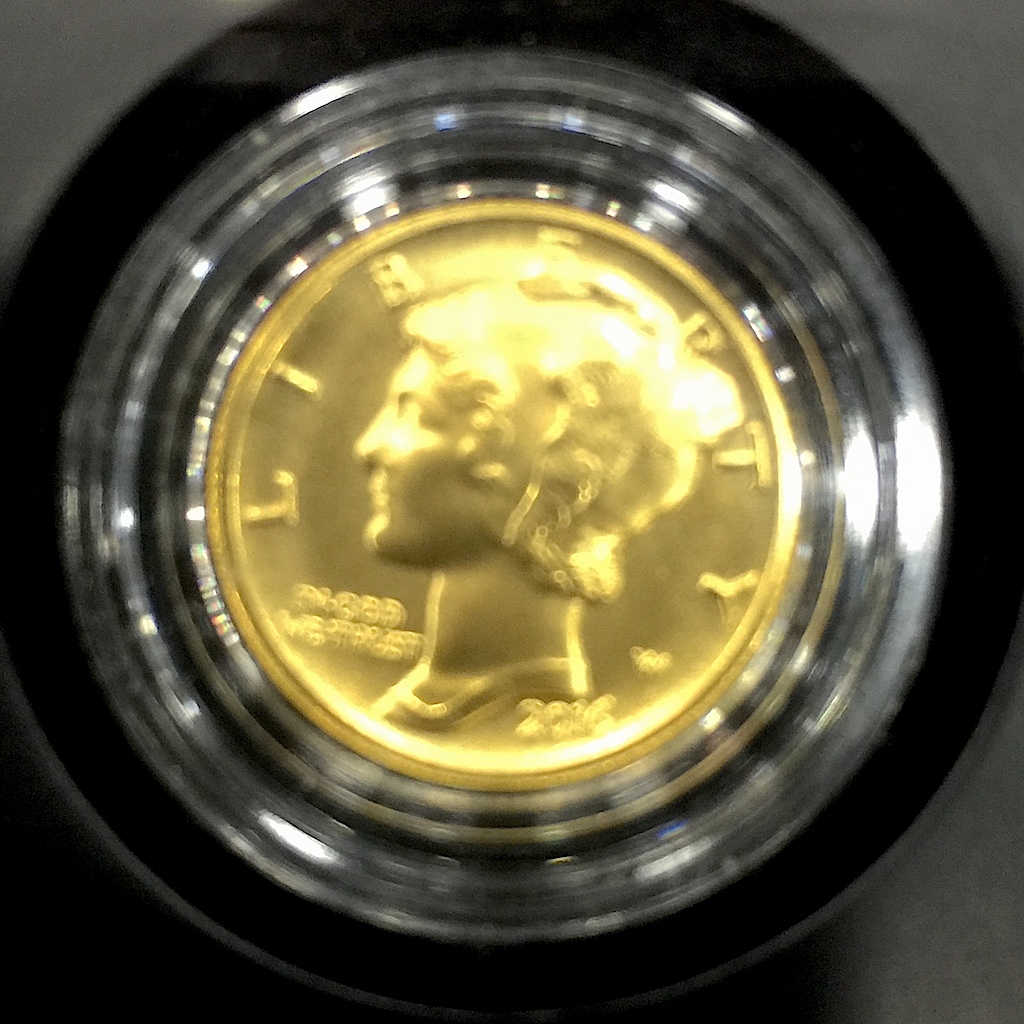
Obverse of the soon to be released Mercury Dime 2016 Centennial Gold Coin
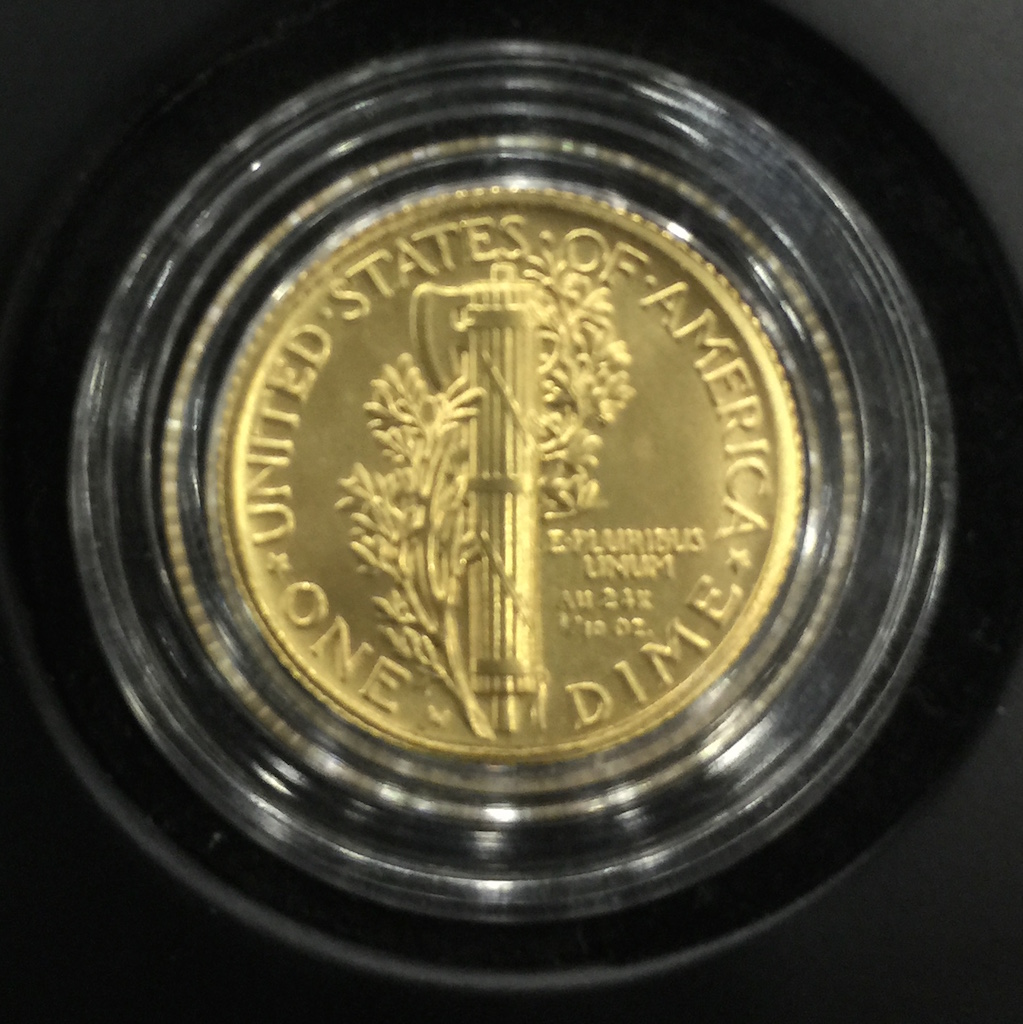
Reverse of the soon to be released Mercury Dime 2016 Centennial Gold Coin
With a mintage limit of 125,000 and struck in West Point, the coin will be struck on a 24-karat (.999 pure) gold planchet. It will differ from the original Mercury Dime in that it will be dated 2016. On the reverse the coin will have the “W” mintmark since it will be struck in West Point, include “AU 24K” and “1/10 OZ.” to note that the coin will contain one-tenth ounce of gold. Otherwise, it looks exactly like Adolph A. Weinman’s design that was used from 1916 through 1945.
At 16.50 mm in diameter, the gold coin will be a little smaller than the 17.91 mm silver dime. The gold coin will be heavier (3.11 g) than the original that was made from 90-percent silver (0.7234 troy ounces).
To make this coin, the U.S. Mint is exploiting a loophole in the law that authorized the American Buffalo 24-Karat Bullion Gold Coins program (31 U.S.C. § 5112(q)). According to the law, after the first year of issue (2007), the Secretary can change the design of the coin as long as the design is reviewed by the Commission of Fine Arts and Citizens Coinage Advisory Committee. The U.S. Mint used this law to authorize the 2009 Ultra High Relief coin and the fifty year celebration of the Kennedy half dollar in 2014 with the dual date.
The original Winged Liberty “ Mercury” Dime was a silver coin produced as a result President Theodore Roosevelt’s “pet crime” where he thought U.S. coin design was hideous. Weinman was Augustus Saint-Gaudens’ student who is credited with finishing the work on Saint-Gaudens coin designs after the master sculpture’s death. It was not one of Weinman’s favorite works but it is beloved by collectors.
As a collector who has an almost complete collection of Mercury dime (missing the 1916-D), I was skeptical about the visual appeal of the coin in gold. When I open the folder, I see 30 years of silver coins. Since I try to keep my collection at extra fine (XF) or better, you can get used to seeing that beautiful silver color. When I saw the gold coin in a size that is close to the original dime in the presentation box at the Whitman Expo, I thought it made for a beautiful tribute.
Pricing of the coin will depend on the London Bullion Market Association (LBMA) afternoon price of gold on Wednesday, April 20. That number will be plugged into their pricing grid to determine the opening price of the coin. For example, the LBMA PM price of gold on April 14 is $1,233.85 per troy ounce. If this was the basis of the opening price, we would look up in the table for the price range $1,200.00 to $1,249.99. Since this is an uncirculated business strike coin struck under the American Buffalo act, the table shows that the coin would open at $194.00.
Using my example, this would give the coin a $70.61 or 36-percent numismatic premium over the spot price, which also takes into account U.S. Mint production costs (materials, labor, packaging, etc.).
If the LBMA PM price goes over $1,250 then the opening price of the coin will be $199.00. Being under $200.00 may give the market a psychological boost that may promote quicker sales. Then again, if the price of gold dips below $1,200.00, the coin will open at $189.00.
Putting on my prognosticator’s hat, I predict that the price of gold will go up enough that the opening price will be $199.00.
NOTE: I am just a blogger making a prediction. If you want a better market analysis, ask a professional advisor. They may have a more informed opinion, but we are all just throwing ideas up against the wall trying to figure out what will stick!
Apr 13, 2016 | auction, Baltimore, coins, medals, US Mint

Whitman Spring 2016 Expo looking into Hall C
Those who followed me on Twitter knows that I had a late start. We working stiffs do have weekend responsibilities that have to be taken care of before we can go out to play. Once I was able to complete my errands, I was able to travel north to Baltimore.
I may be one of the few people who are not from Baltimore who likes Baltimore. But going to Baltimore’s Inner Harbor area can be a lot of fun, even if it is frustrating trying to find parking. Then again, show me any city that does not have a parking problem and I will show you a city that is not as fun.
Once I was able to find parking I walked to the convention center. After entering in the early afternoon on Saturday I was struck by the number of empty tables that could be seen from the entry door. In all areas of the three convention center halls, the number of empty tables was surprising. I was also surprised to see a number of shared tables being half used.
As I walked around the convention center floor I was struck by the number of tables that were either never occupied or the dealer did not show up at all on Saturday. You can tell these tables from the others by the number of fliers left on the table. Some tables had rental cases with the keys in them showing that these tables were either unused or the dealer left early.

Dealer attendance inside Hall B

Another view of the dealer attendance on Saturday
I recently learned that a table for the Baltimore show costs $750. Add the cost of travel, food, lodging, and the inventory, does the costs justify leaving and not trying to make money? When I discussed this with a regular dealer, I was told that some that are not having a good show will leave early to cut their losses.
Of the dealers that were left, there was a nice mix of items. For once, I did not get the impression that one type of coin was more popular than the other. In fact, I think this is the first show where bullion and bullion-related coins were not the focus. I was able to find American Silver Eagles without problem but finding some of the foreign bullion coins was a little more challenging.

Obverse of the to be released 2016 Mercury Dime Centennial Tribute
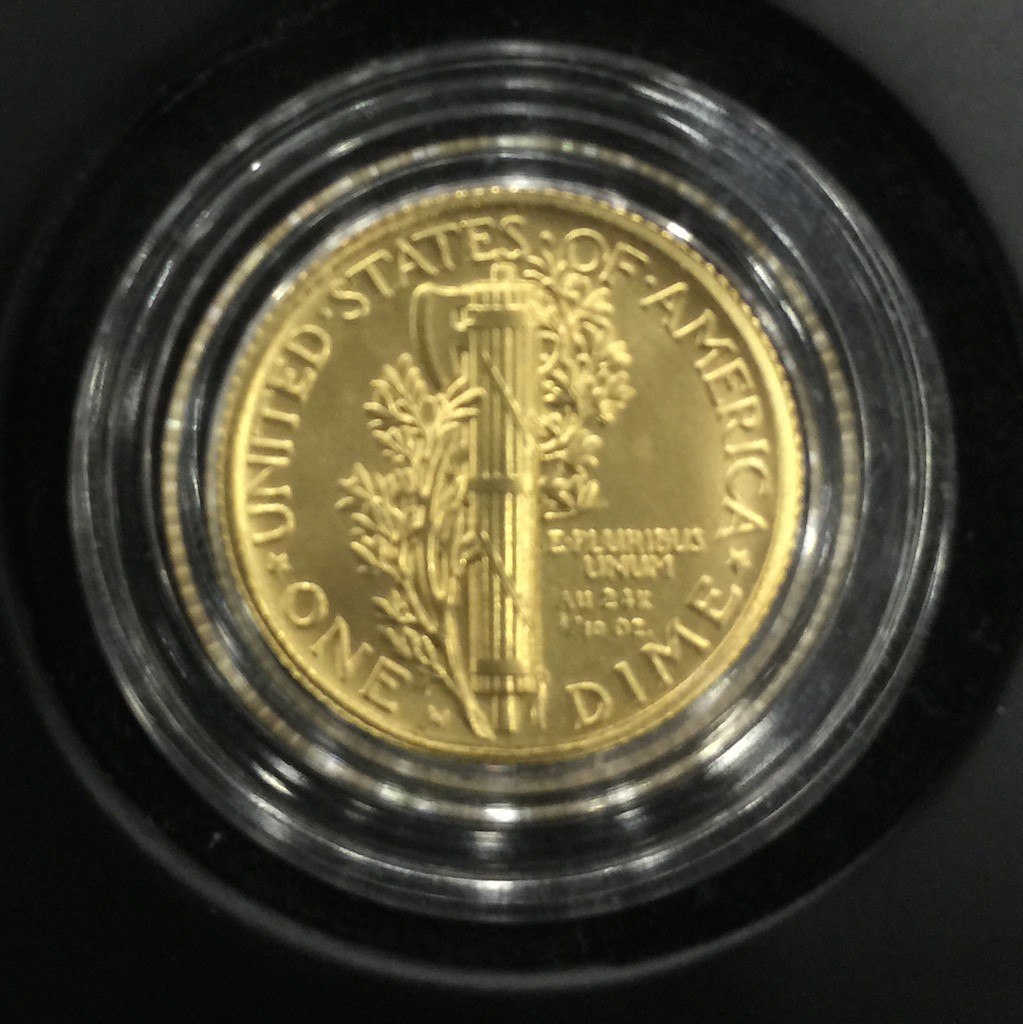
Reverse of the to be released 2016 Mercury Dime Centennial Tribute
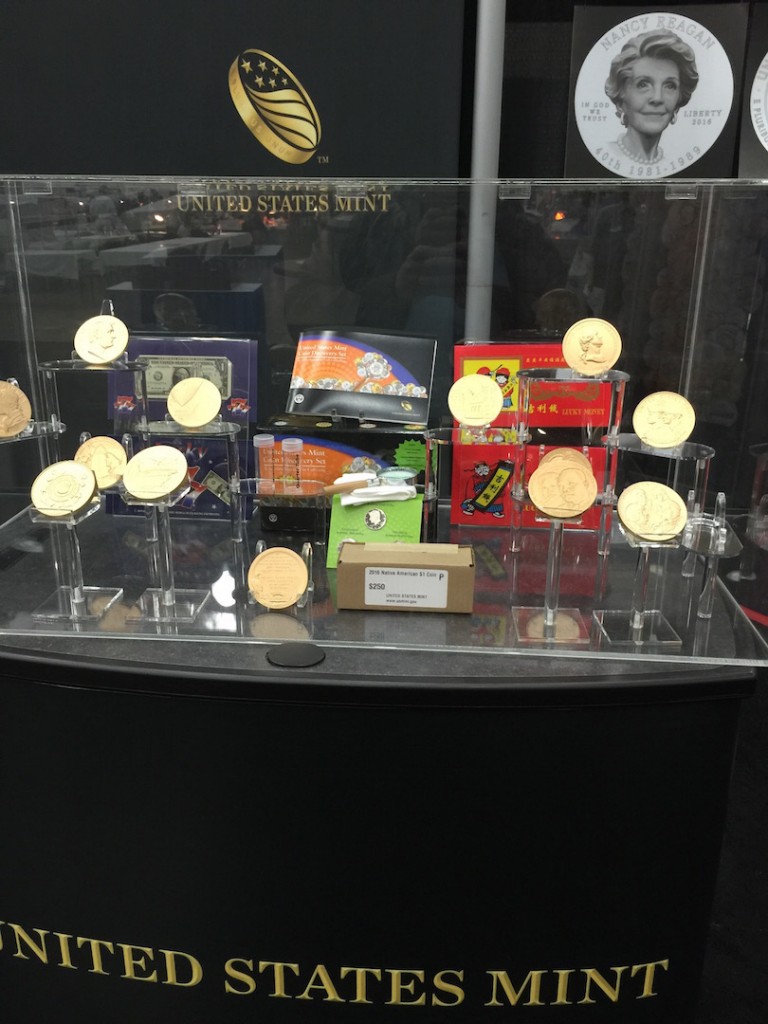
Medals on display at the U.S. Mint booth

Shawnee National Forest 5 ounce silver coin
Whitman, the sponsor of the show, had their own booth and was actually selling discounted items. In prior years, Whitman would sell their own products at full price but this time offered some discount. And they had a clearance table. I did not buy from the clearance table because they did not have anything I wanted but there were some nice and current items that were worth the value.
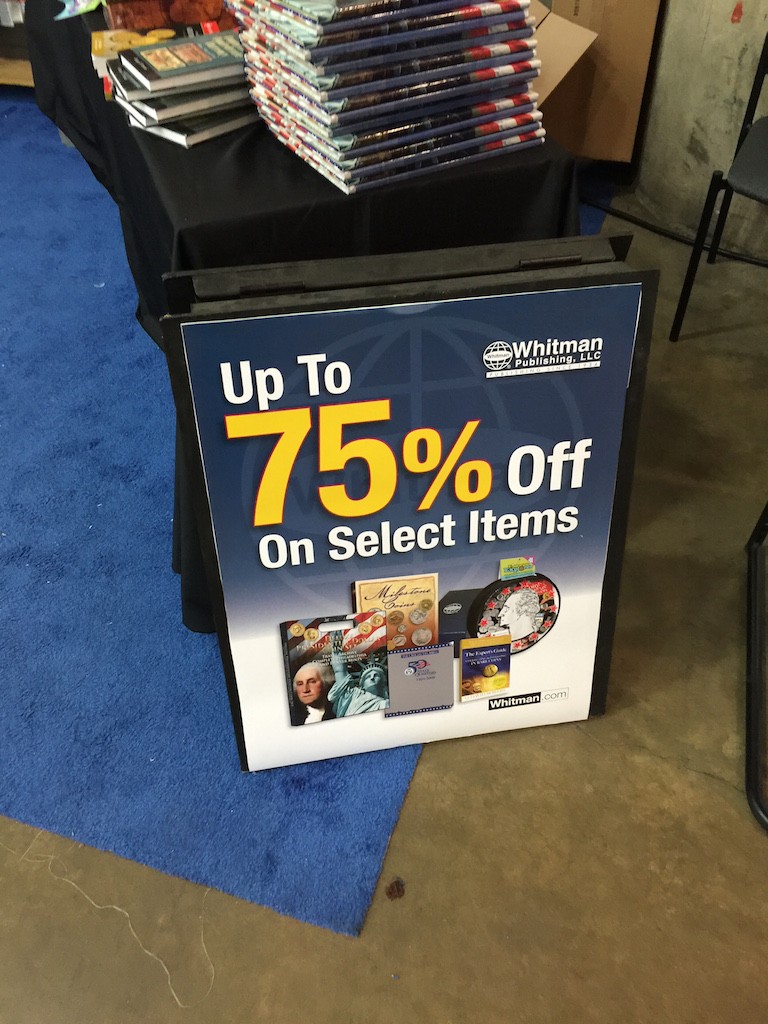
Sale at the Whitman Booth!
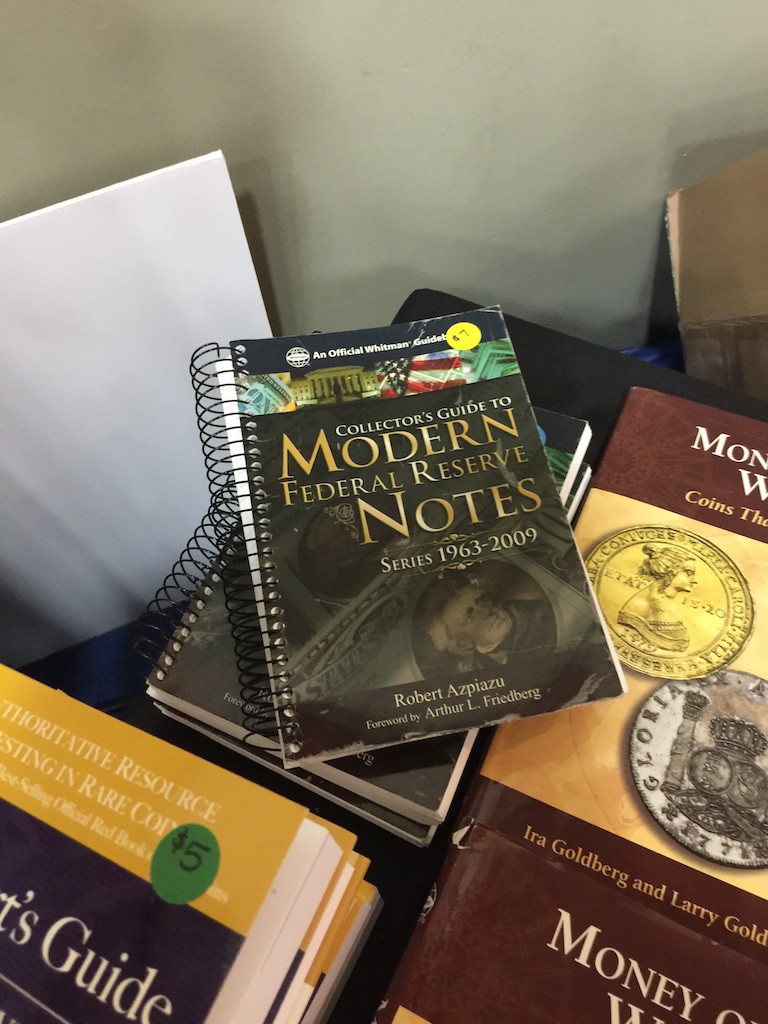
There were good collectors guide books on the sale table
One thing Whitman did was to give away hardcover copies of the 70th Edition of the Red Book autographed by Ken Bressett and Jeff Garrett. All I had to do was fill out a ticket at the Whitman booth, return to the booth at the time of the drawing, and wait for them to give away the eight books being offered on Saturday. I think I was the fourth book given away.
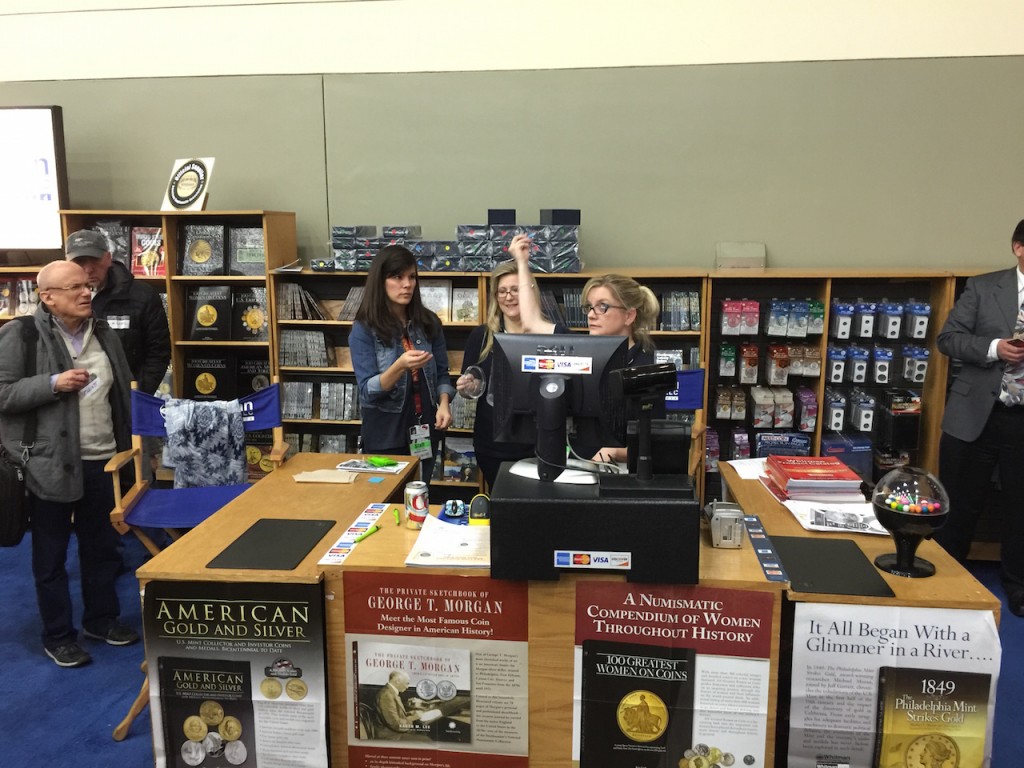
Drawing for the autographed Red Book
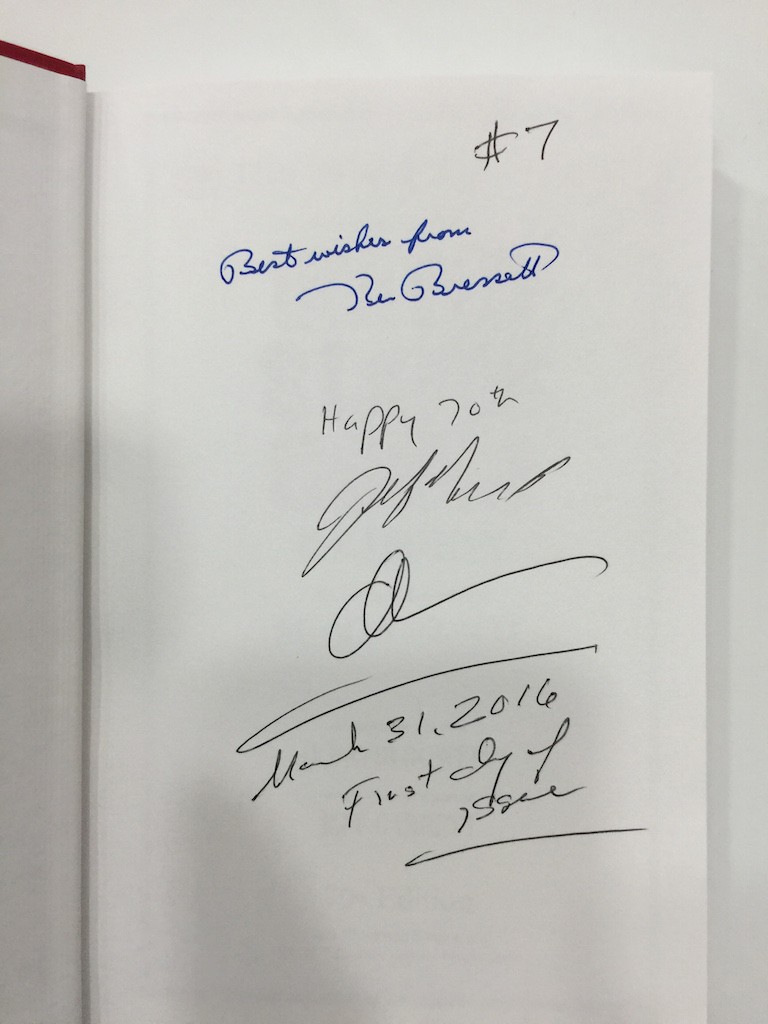
I WON! It looks like I received lucky #7.
Previously, I noted that the choices of numismatic literature has diminished. While the death of numismatic book dealer John Burns is a tragic story in and of itself, what has not happened is that someone has not stepped into that market. Aside from being intelligent and a character with a sharp wit, his inventory was so varied that I was always able to find something a little off-beat or out of the ordinary that was intriguing. If someone wants to move into numismatics but wants to occupy a different space, this might be something for you to get into.

Swimming in the pools of inexpensive slabs.
Every show I try to find one neat item that is out of the ordinary. As I approached one table I noticed there were a few large brass medals on the table. I am intrigued by brass medals both for their size and a lot of the artwork. I have seen many brass medals with art that rival anything produced on canvas for their beauty. But this one was different in that it bore the local of Carnegie Mellon University, where I went to graduate school.
Carnegie Mellon was formed in 1967 when the Carnegie Institute of Technology (Carnegie Tech, founded in 1900) merged with the Mellon Institute of Industrial Research (founded in 1913). I earned a masters degree in one calendar year 1999-2000. Although I was an older student, it was a great experience for me and my (late) first wife.
The reverse of the medal is an image of Hamerschlag Hall, the first permanent building of Carnegie Tech and the home of the current College of Engineering. Around the rim celebrates the 50 Year Reunion with a space for the college which is having the reunion and the year being celebrated. Since the date engraved on the reverse is 1938, it was given to its previous owner in 1988. But that does not bother me. The front has the Carnegie Mellon logo and a great reminder of my good year in Pittsburgh.
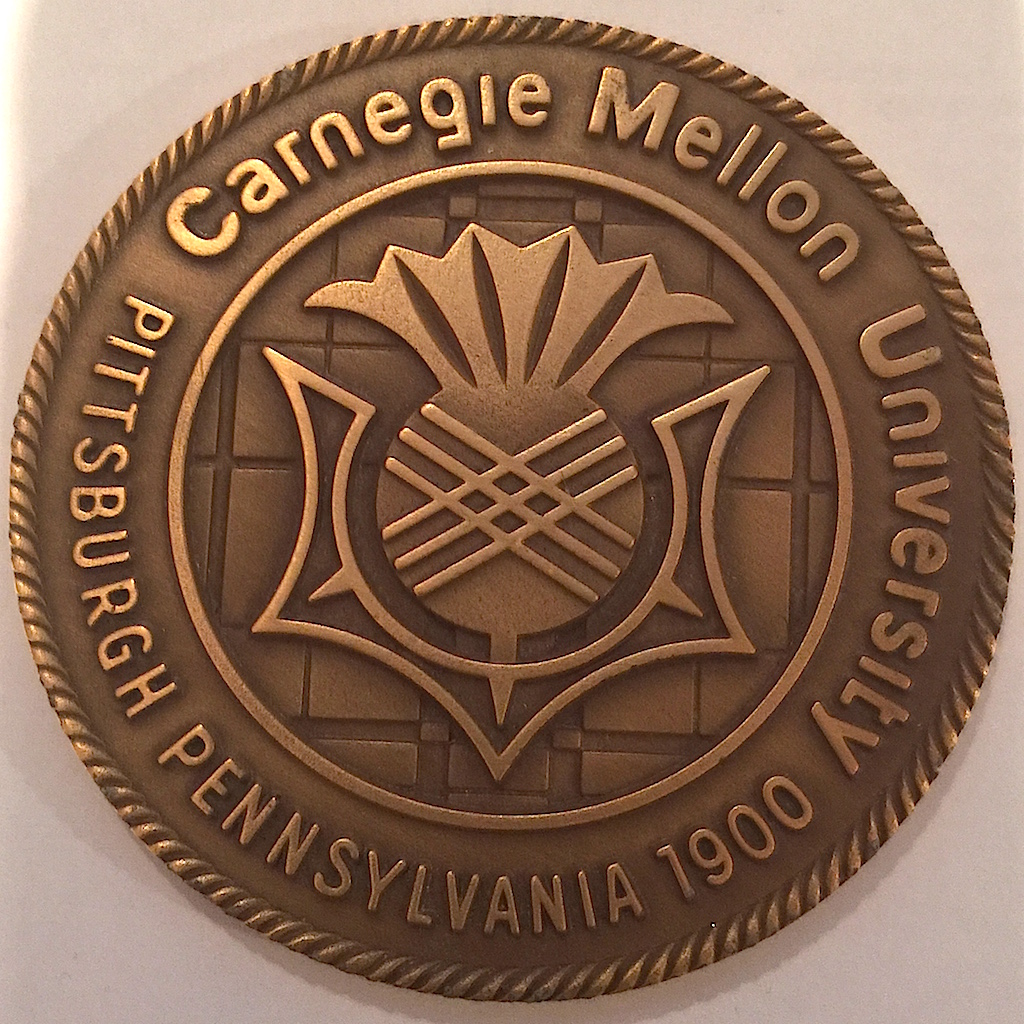
Obverse of the Carnegie Mellon University medal features the school’s logo
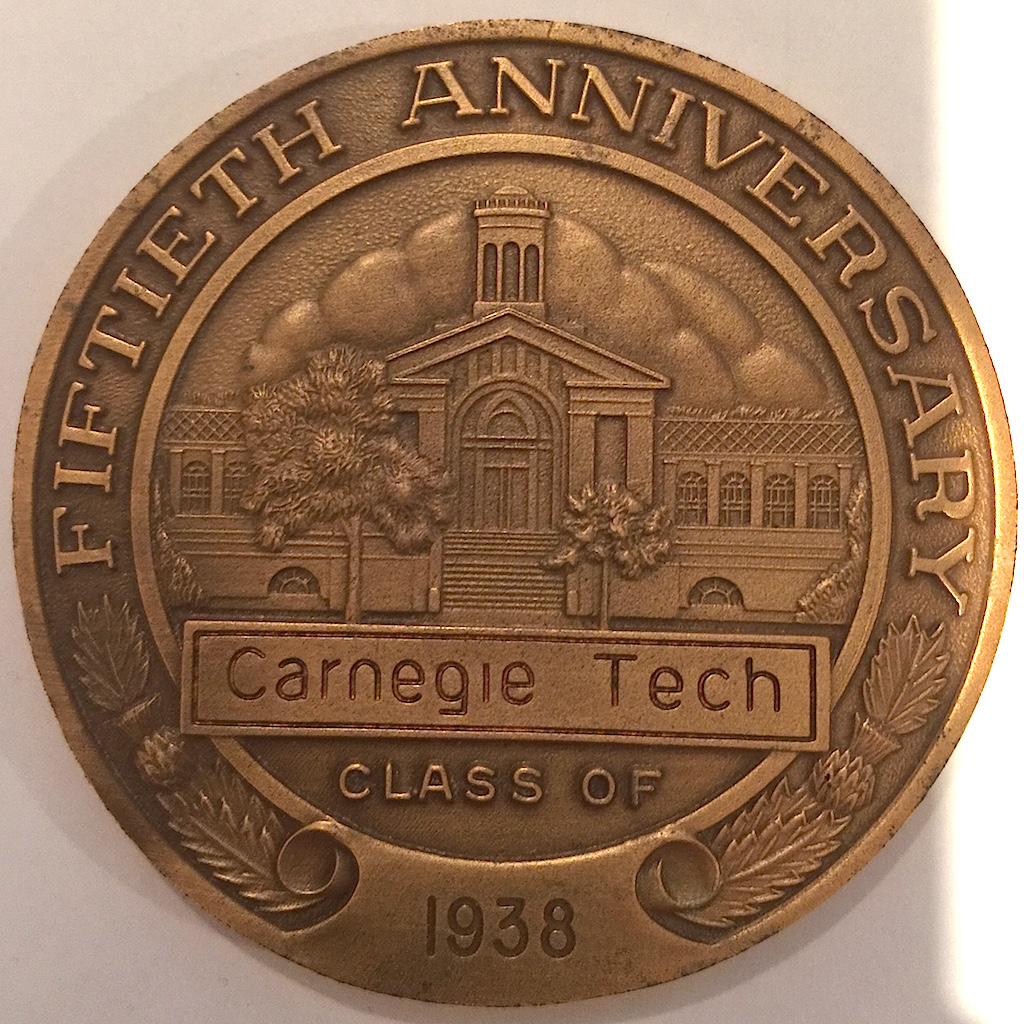
Reverse of the Carnegie Mellon University medal features Hamerschlag Hall and proclaims the 50th Anniversary reunion Class of 1938.
The next Whitman Expo will be July 14-17. I hope the dealers that show up will be there if I have to spend the morning running errands.
Gallery of images
This slideshow requires JavaScript.
Apr 6, 2016 | coins, legislative
 At the beginning of the month I usually summarize the numismatic-related legislation from the previous month. In March, congress spent two weeks on spring break and before that they were more concerned over what to do when the president nominated someone to the Supreme Court. Interestingly, the nomination came just as congress went on spring break.
At the beginning of the month I usually summarize the numismatic-related legislation from the previous month. In March, congress spent two weeks on spring break and before that they were more concerned over what to do when the president nominated someone to the Supreme Court. Interestingly, the nomination came just as congress went on spring break.
I visited one of my senators shortly after Merrick Garland’s nomination and the halls were empty. Although there was an attempt to have him speak with members of the senate, the building I was in was a virtual ghost town. Many of the staffers went on break to escape the general lunacy.
That does not mean there was no business. Some bills were introduced including the nited States Semiquincentennial [sic] Commission Act of 2016 (H.R. 4875). If passed, the bill will create a commission similar to the American Revolution Bicentennial Administration to celebrate the 250th anniversary of the signing of the Declaration of Independence in 2026.
As a young numismatist in 1976, there was ample opportunity to collect many tokens and medals celebrating the nation’s bicentennial. If you want proof of that, just search eBay for the number of bicentennial numismatic-related items for sale.
According to the bill, it encourages “Federal agencies to integrate the celebration of the Semiquincentennial [sic] into the regular activities and execution of the purpose of the agencies through such activities as the issuance of coins, medals, certificates of recognition, stamps, and the naming of vessels.”
Interestingly, “Semiquincentennial” does not appear to be a proper word. A “ quincentennial” would be used to celebrate the 500th anniversary of an event. I do not believe this is a proper use of the prefix “semi.” According to Wikipedia, a proper term would be “sestercentennial.”
To express 2½ in Latin it would be expressed as “half-three”. The term relates to being halfway [from the second] to the third integer. In Latin this is “Sestertius” which is a contraction of semis (halfway) tertius (third)—hence Sestercentennial.
Wikipedia notes that Semiquincentennial has been used as recently as 2015 by Brown University. Bicenquinquagenary was used by Princeton University; Reading, Pennsylvania; and Washington and Lee University.
If these places cannot decide, then maybe let congress do so. They could do worse things!
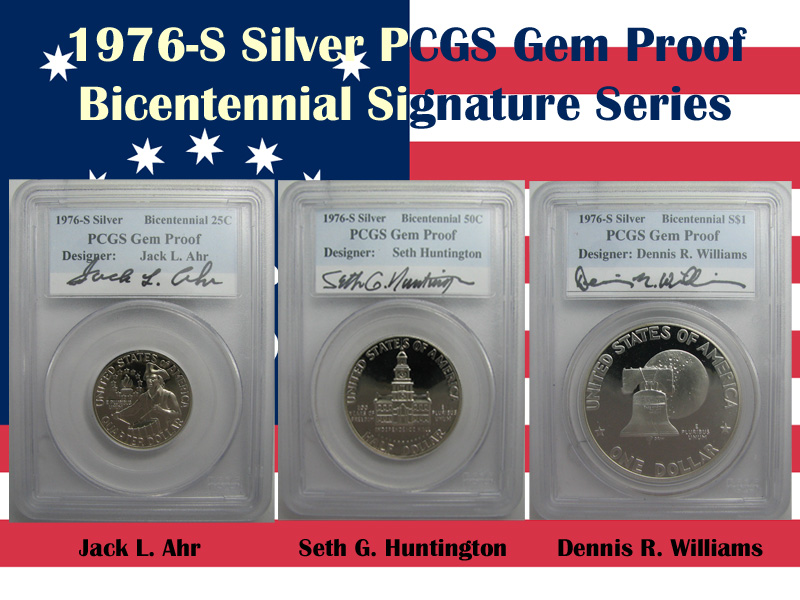
1976-S Silver Proof Bicentennial Autograph Set
Image from the author’s personal collection.
Mar 26, 2016 | coins, education, US Mint, video
 Since the beginning of the year, the U.S. Mint has been issuing a lot of video content primarily videos regarding the launch of America the Beautiful Quarters coins and B-Roll video. This past week, the U.S. Mint issued a new “How Coins Are Made… For Kids!” video as part of their H.I.P. (History In your Pocket) Pocket Change educational program.
Since the beginning of the year, the U.S. Mint has been issuing a lot of video content primarily videos regarding the launch of America the Beautiful Quarters coins and B-Roll video. This past week, the U.S. Mint issued a new “How Coins Are Made… For Kids!” video as part of their H.I.P. (History In your Pocket) Pocket Change educational program.
As opposed to prior videos, rather than have the entire video animated, it uses a combination of animation and the B-Roll video the U.S. Mint published last month. It is done in a way that tells a very coherent story without being cheesy. Everyone will enjoy this video, even if they are just a kid at heart.
If you have an interest in good videos that have been issued by the U.S. Mint you should subscribe to their YouTube Channel. Some of the recent videos that I recommend include an interview with Cassie McFarland, design contest winner for the 2014 National Baseball Hall of Fame Commemorative Coin; B-Roll showing the sculptor-engravers at the Philadelphia Mint; Episode 1 of their “My Favorite” where they interview San Francisco employees about their favorite coins; and “Maryland Quarter in Space” interview with William Krawczewicz, designer of the Maryland State Quarter after Maryland and Florida coins traveled aboard the New Horizons spacecraft.
What is B-Roll
“B-Roll” is a television term for background video that is interspersed within a story. It received its name from the days of editing video segments on film where the primary film that contained the story with the reporter talking was on the “A” or primary roll of film. During the story, there would be other elements cut in with background and other video that was on another reel called the B-Roll. The term has survived through the video and now digital era. Modern B-Roll is now called stock footage.




 Sen. Bob Casey (D-PA) introduced the United States Semiquincentennial Commission Act of 2016 (S. 2815). This bill is the same as H.R. 4875 introduced in the House by Rep. Patrick Meehan (R-PA) in March. Both bills seek to create a commission to celebrate the nation’s 250th birthday in 2026 similar to the bicentennial celebration of 1976. See
Sen. Bob Casey (D-PA) introduced the United States Semiquincentennial Commission Act of 2016 (S. 2815). This bill is the same as H.R. 4875 introduced in the House by Rep. Patrick Meehan (R-PA) in March. Both bills seek to create a commission to celebrate the nation’s 250th birthday in 2026 similar to the bicentennial celebration of 1976. See 





 As luck would have it, the day I published
As luck would have it, the day I published 






















